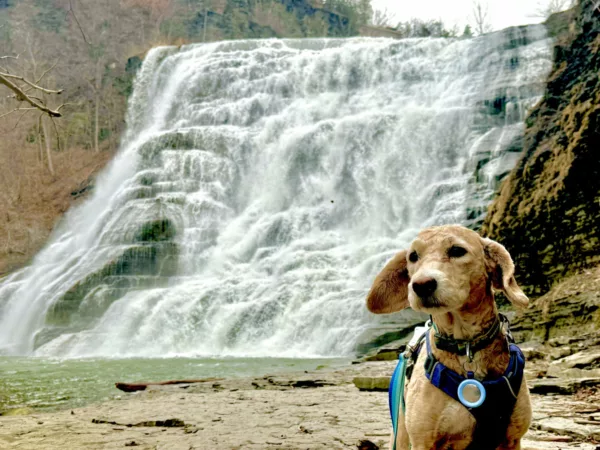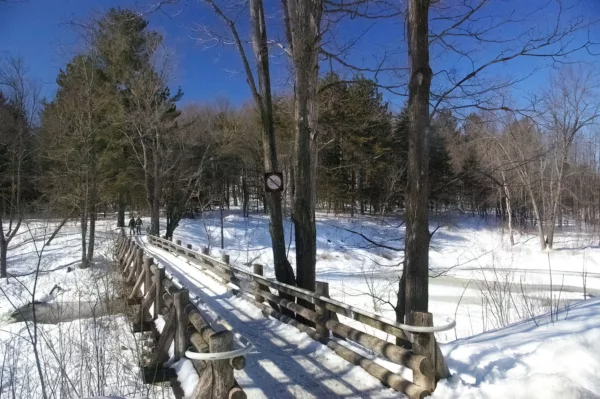How to Train an Outdoorsy Dog
I’m at a puppy-class learning the basics of how to groom a hyperactive pup into a dutiful dog. It’s all very helpful for the day-to-day.
But looking around at the other canines—a Jack Russell/Chihuahua cross, an English Bulldog—I see perhaps one other mutt that would even be capable of the outdoor adventure I have planned for my new best friend, a Lab-pointer mix.
It’s clear I’ll need to dig for some tailor-made skills. In addition to the useful commands of “look, sit and come,” I need to scrounge advice on campsite etiquette, safe canoeing and respectful hiking that humans learn in places like Boy Scouts and Girl Guides.
There are no Dog Scouts. Yet.
Ruffwear makes some of the best outdoors gear for dogs. They’ve recently expanded heavily into Canada. So to correspondingly expand my training repertoire, I polled their staff for info on how to train an outdoorsy dog.

Doggy Hiking Tips & Tricks
According to the staff at Ruffwear, for starters, your pup should be well-socialized and responsive to voice commands before you even consider going for an off-leash hike. Then, ensure you’re in an area that permits a free-roaming Fido. (National Parks, for example, are out.)
Next, focus on rewarding good behaviour with treats. Does he come when called? Stay in-sight? Sit politely when encountering fellow hikers? Good decision-making deserves treats and praise. Realize you’re dealing with a dog—your leash should be at-the-ready. Wildlife, horses, other canines, fellow hikers—these are all reasons to leash-up. Not everybody loves dogs nor wants your pup sniffing them up and down, so always give right-of-way to the dogless.
Just like you, your dog should be well-hydrated, well-fed and, if he’s wearing boots (yes, they make hiking boots for dogs—and they’re great assets, reducing injuries, insulating and increasing grip), they should be broken in slowly before attempting longer treks. To break-in doggy boots, first have the pup wear a well-fitted pair around the house. When it’s time to go outside, motivate with treats. (He may do what Ruffwear staffers dub “the boot dance,” as he gets used to those funny things on his paws.) Stop frequently and check for rubbing and hot spots. If you have a lightweight pup who may take a while to wear-in new boots, help the dog along by massaging the boots by hand in-between walks to soften the materials
Dog backpacks are another wonderful invention. Why shouldn’t Fido carry his share? But you can’t expect to strap on a pack at the trailhead and have your dog be as happy as his owner.
Begin by having your dog wear an empty pack at home, where he’s comfortable. Reward, or remove the pack if the dog is stressed. Once the dog becomes used to the backpack, add some light weight—like a towel or newspaper. Slowly increase with various shaped items—stopping when you get to about 25 per cent of your dog’s weight. That’s the max for hiking.
Doggy Day-Hiking Checklist
- Leash
- Poop bags
- Water
- Bowl
- Treats
- First-Aid Kit
- Optional: Pack & Boots
Comfy in a Canoe
Greg Freyberg, Ruffwear’s Specialty Product Line Manager, offers these tips for getting your canine in a canoe:
- Buy a well-fitted lifejacket and let your dog get accustomed to it on land—running around the yard or house helps.
- Encourage your pup to get in the canoe on-land. Lure with treats. Let Fido get used to the feel of the canoe.
- Ensure your canoe-launch is quick and smooth. Seat your dog in the bow, then push-off without delay. When your dog can no longer see bottom, he’s less likely to jump out.
- If the hull shape of a canoe is causing your dog to be restless and uncomfortable, consider laying a piece of plywood (or similar) to create a flat area.

Ruffwear’s Canine Camping Courtesies
Pick it up. This one should go without saying, but it bears repeating that even deep into the back-forty, you should pick up your dog’s poop.
Maintain control. You’re walking your dog, not the other way around. Losing control of your pup in the woods can mean harassing wildlife, damaging sensitive flora and disturbing campers. Also, consider using a fixed-lead at the campsite—this gives your pup freedom to roam without the ability to dash into the next site for s’mores.
The campground is not a fire hydrant. Don’t let your pup pee near food preparation areas, swimming zones or kid’s play areas.
If you bring them along, don’t leave them behind. Leaving your pup alone at the campsite can mean howling, barking and perhaps even dangerous situations like getting attacked by wildlife or eating something they shouldn’t. Fido wants to have fun too!
Your Dog Is Ready…
…Are You?
Get The Gear. Get Inspired.
(Save Money, Too. Scroll To Discover!)

You need quality gear…
(that won’t break the bank)
You need inspiration and community…
(to help you stay active and adventurous)
WE HAVE BOTH.
Join our club. Get the gear. Get the inspiration.
Click here to learn more.
We guarantee you’ll love it.
Explore’s Live the Adventure Club Gear Box
Fellow explorer,
Imagine, standing atop a bluff overlooking a pristine lake, enveloped in the silence of nature. You snap a quick photo to capture the moment. Now, imagine the rush of sharing this moment and…
Related Content
20 Dog-Friendly Hiking Trails Near Vancouver, BC














